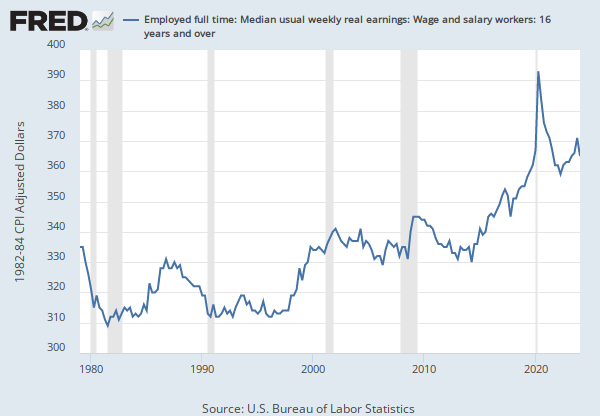Observations
2023: 1.1 | Percent of Total Paid Hourly Rate, Not Seasonally Adjusted | Annual
Updated: May 28, 2024 5:31 PM CDT
Observations
| 2023: | 1.1 | |
| 2022: | 1.3 | |
| 2021: | 1.4 | |
| 2020: | 1.5 | |
| 2019: | 1.9 |
Units:
Frequency:
Write a custom formula to transform one or more series or combine two or more series.
You can begin by adding a series to combine with your existing series.
Now create a custom formula to combine or transform the series.
Need help?
For example, invert an exchange rate by using formula 1/a, where “a” refers to the first FRED data series added to this line. Or calculate the spread between 2 interest rates, a and b, by using the formula a - b.
Use the assigned data series variables (a, b, c, etc.) together with operators (+, -, *, /, ^, etc.), parentheses and constants (1, 1.5, 2, etc.) to create your own formula (e.g., 1/a, a-b, (a+b)/2, (a/(a+b+c))*100). As noted above, you may add other data series to this line before entering a formula.
Finally, you can change the units of your new series.
Add the minimum, maximum, and average calculations of selected bars to the graph
Write a custom formula to transform one or more series or combine two or more series.
You can begin by adding a series to combine with your existing series.
Now create a custom formula to combine or transform the series.
Need help?
For example, invert an exchange rate by using formula 1/a, where “a” refers to the first FRED data series added to this line. Or calculate the spread between 2 interest rates, a and b, by using the formula a - b.
Use the assigned data series variables (a, b, c, etc.) together with operators (+, -, *, /, ^, etc.), parentheses and constants (1, 1.5, 2, etc.) to create your own formula (e.g., 1/a, a-b, (a+b)/2, (a/(a+b+c))*100). As noted above, you may add other data series to this line before entering a formula.
Finally, you can change the units of your new series.
Add the minimum, maximum, and average calculations of selected bars to the graph
Data in this graph are copyrighted. Please review the copyright information in the series notes before sharing.
Notes
| Title | Release Dates | |
|
|
||
| Total Wage and Salary Workers Paid at or Below Prevailing Federal Minimum Wage: 16 Years and Over | 2016-04-22 | 2024-05-28 |
| Source | ||
|
|
||
| U.S. Bureau of Labor Statistics | 2016-04-22 | 2024-05-28 |
| Release | ||
|
|
||
| Characteristics of Minimum Wage Workers | 2016-04-22 | 2024-05-28 |
| Units | ||
|
|
||
| Percent of Total Paid Hourly Rate | 2016-04-22 | 2024-05-28 |
| Frequency | ||
|
|
||
| Annual | 2016-04-22 | 2024-05-28 |
| Seasonal Adjustment | ||
|
|
||
| Not Seasonally Adjusted | 2016-04-22 | 2024-05-28 |
| Notes | ||
|
|
||
|
Wage and salary workers are workers age 16 and older who receive wages, salaries, commissions, tips, payments in kind, or piece rates on their sole or principal job. This group includes employees in both the private and public sectors. Workers paid by the hour are employed wage and salary workers who report that they are paid at an hourly rate on their job. Estimates of workers paid by the hour include both full-time and part-time workers unless otherwise specified. All self-employed workers are excluded whether or not their businesses are incorporated. The estimates of workers paid at or below the federal minimum wage are based solely on the hourly wage they report (which does not include overtime pay, tips, or commissions). Salaried workers and other nonhourly paid workers are also excluded. It should be noted that some respondents might round hourly earnings when answering survey questions. As a result, some workers might be reported as having hourly earnings above or below the federal minimum wage when, in fact, they earn the minimum wage. For more information see https://www.bls.gov/cps/earnings.htm#minwage |
2016-04-22 | 2024-05-28 |
Release Tables
Permalink/Embed
modal open, choose link customization options
Select automatic updates to the data or a static time frame. All data are subject to revision.










